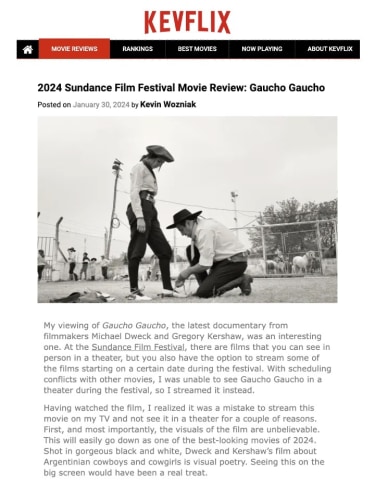2024 Sundance Film Festival Movie Review: Gaucho Gaucho
Kevflix
01/30/2024
Back
by Kevin Wozniak
My viewing of Gaucho Gaucho, the latest documentary from filmmakers Michael Dweck and Gregory Kershaw, was an interesting one. At the Sundance Film Festival, there are films that you can see in person in a theater, but you also have the option to stream some of the films starting on a certain date during the festival. With scheduling conflicts with other movies, I was unable to see Gaucho Gaucho in a theater during the festival, so I streamed it instead.
Having watched the film, I realized it was a mistake to stream this movie on my TV and not see it in a theater for a couple of reasons. First, and most importantly, the visuals of the film are unbelievable. This will easily go down as one of the best-looking movies of 2024. Shot in gorgeous black and white, Dweck and Kershaw’s film about Argentinian cowboys and cowgirls is visual poetry. Seeing this on the big screen would have been a real treat.
The other issue I faced with streaming the film was that subtitles of the film were in white and were difficult to see during some scenes, particularly the scenes set in the daytime when the white of the screen seemed like it was glowing. On the big screen, I don’t think I would have had an issue with seeing the subtitles because they would have been significantly bigger. I watched the film on a good-sized TV, but still, the subtitles vanished in some scenes.
But here’s the thing: it didn’t matter. As the great Alfred Hitchcock once said, “If it’s a good movie, the sound could go off and the audience would still have a perfectly clear idea of what was going on.” That was the case for my viewing of Gaucho Gaucho. While I could not read a lot of the dialog, I still loved the movie and the images on the screen told a compelling story. Much like Dweck and Kershaw’s last film, the wonderful The Truffle Hunters, Gaucho Gaucho is a beautiful slice-of-life documentary where we feel like a fly on the wall in the everyday lives of the film’s subjects. In scenes that feel like mini vignettes, the camera is always stationary as the Gauchos go about their ordinary days. We see them picking corn, herding cattle, going to rodeos, teaching the children how to sharpen a knife, and other day-to-day activities. There is some drama in the film, most notably about how aggressive the condors are and how they keep attacking some of the Gaucho’s cows, but most of the film is just us living with the Gauchos.
Dweck and Kershaw are masters of taking us to small sections of the world and exploring the lives of people we may not have known existed or didn’t even think about, like old men who find thousand-dollar truffles or Argentinian cowboys. They don’t interview the subjects, they don’t have a narrative on the story they want to tell, and they never interfere with what they have going on. They let the camera tell the story of fascinating people in a sophisticated and cinematic manner.